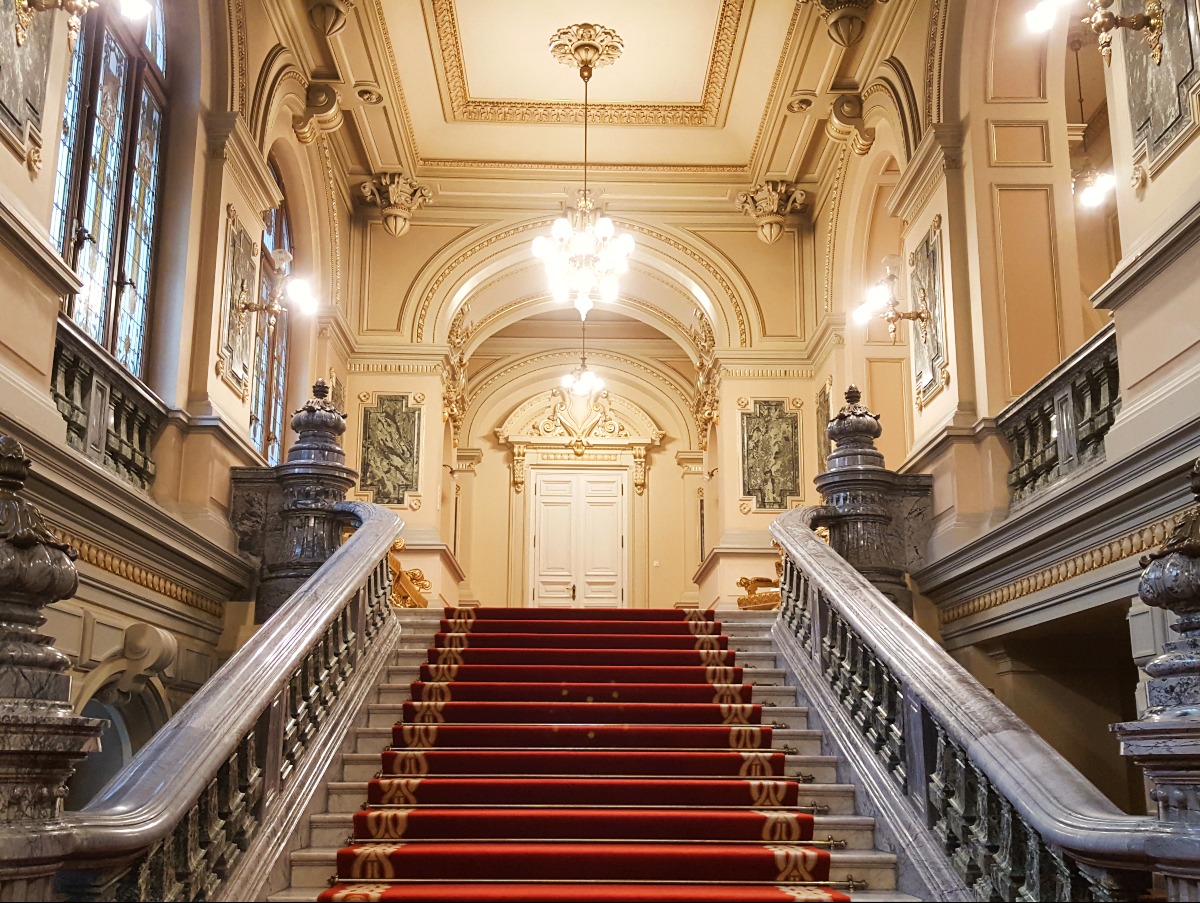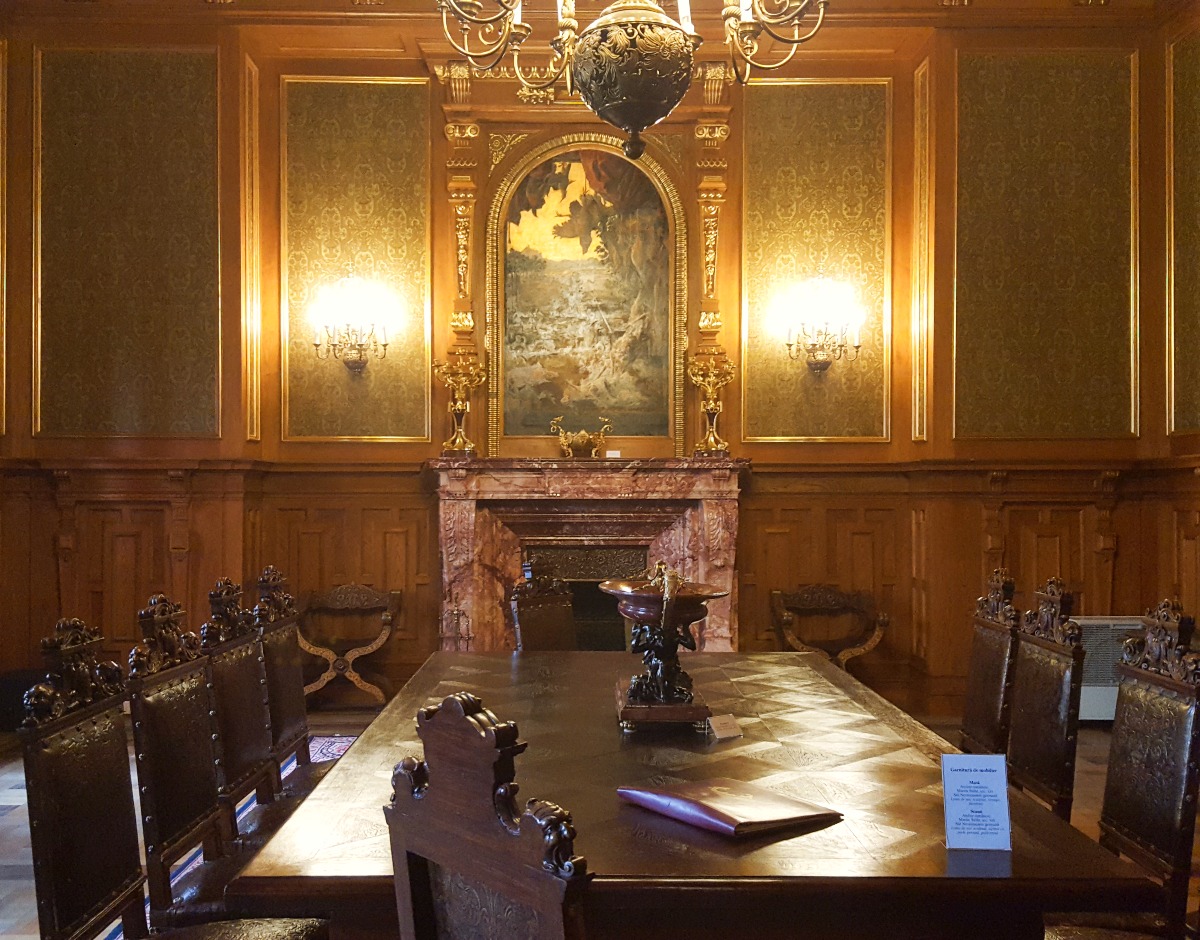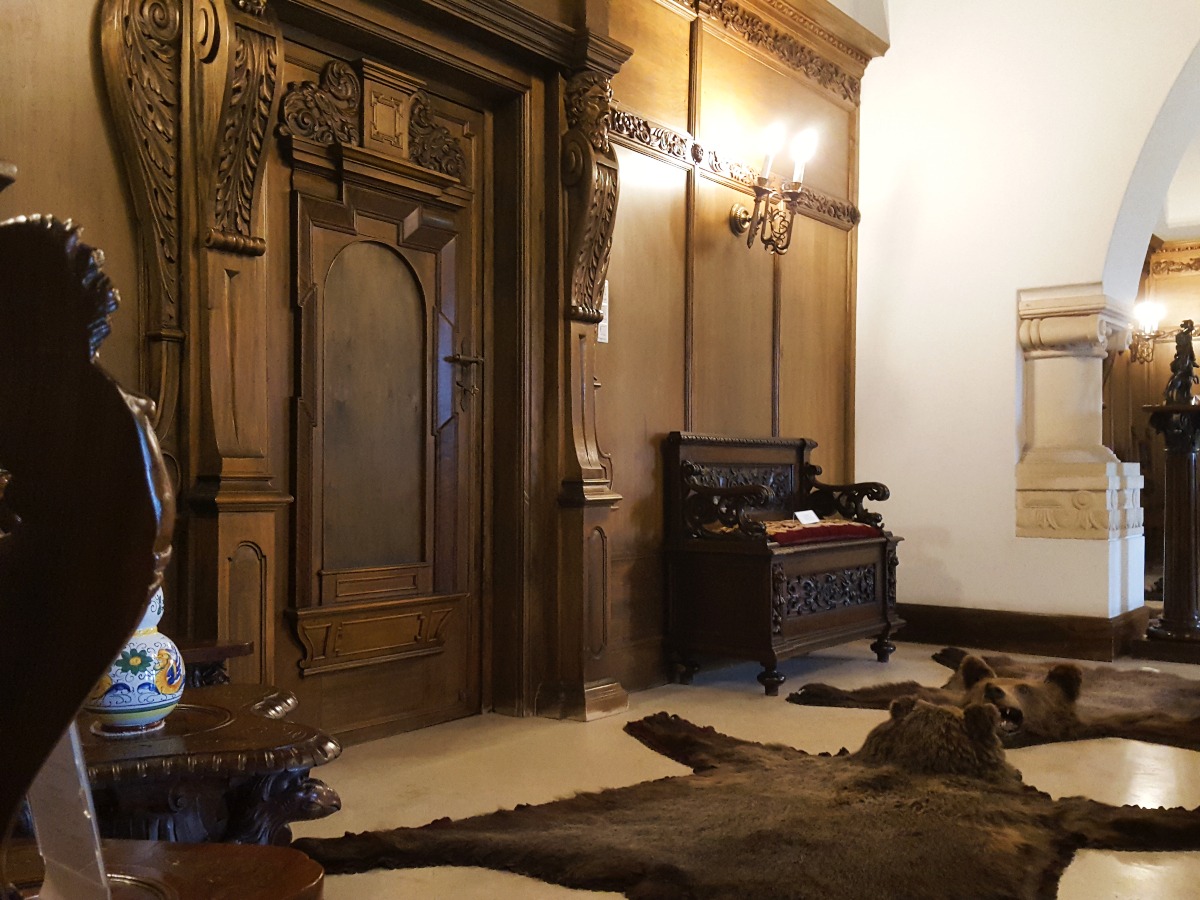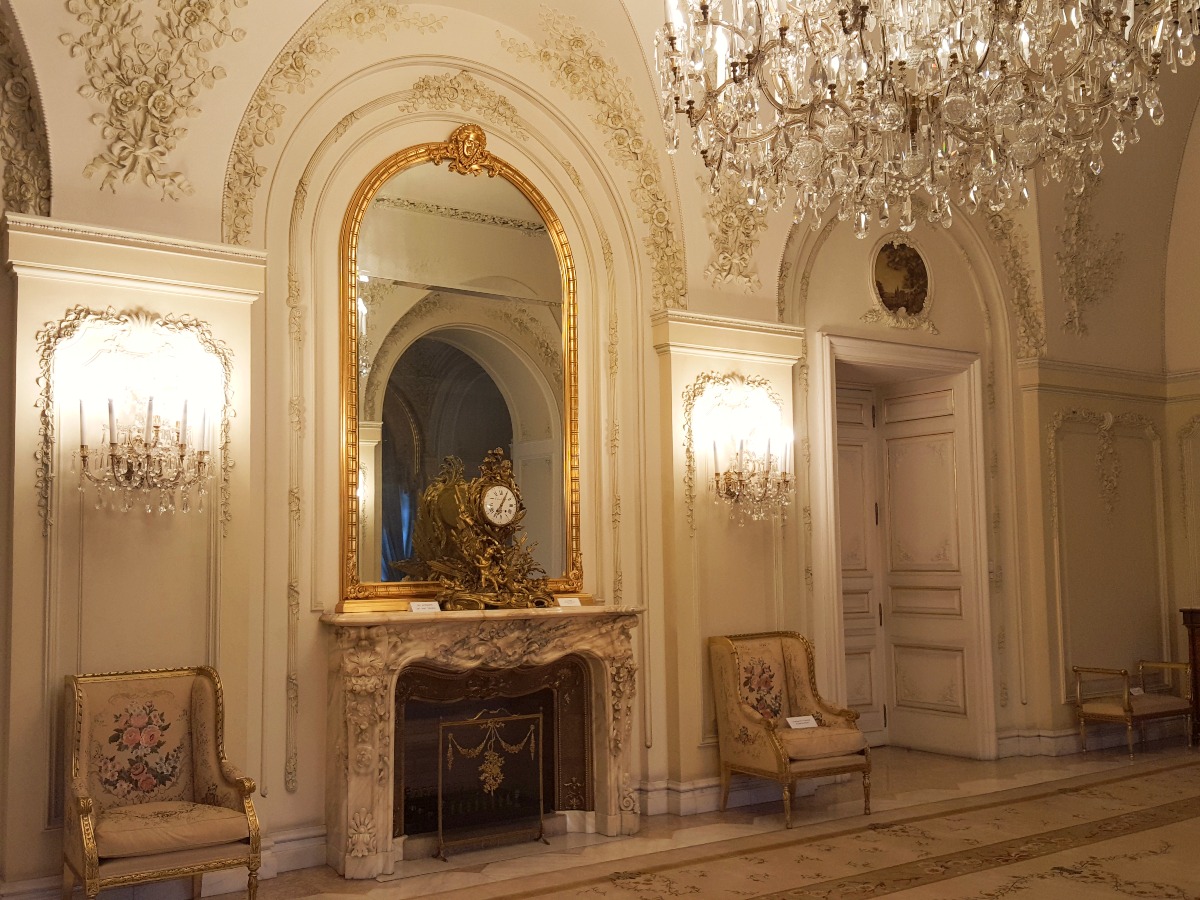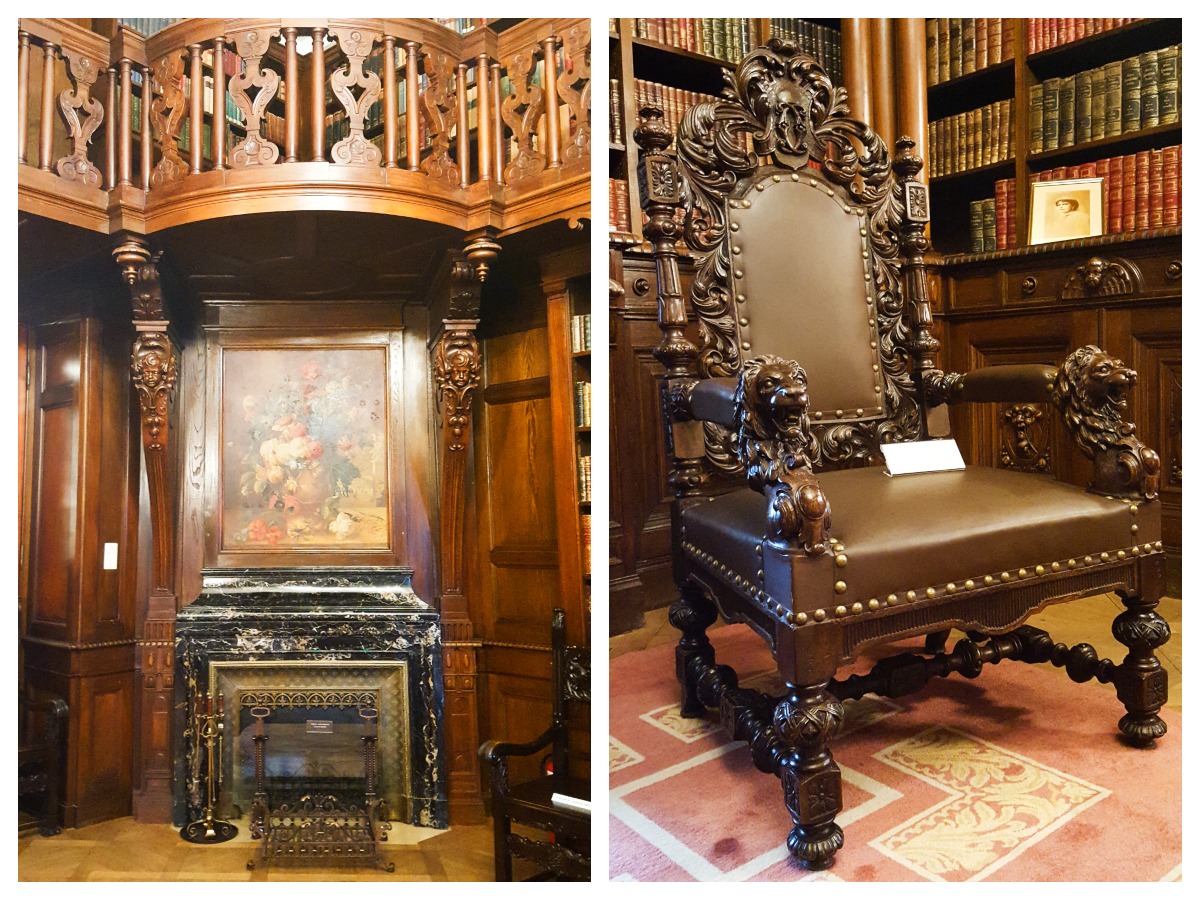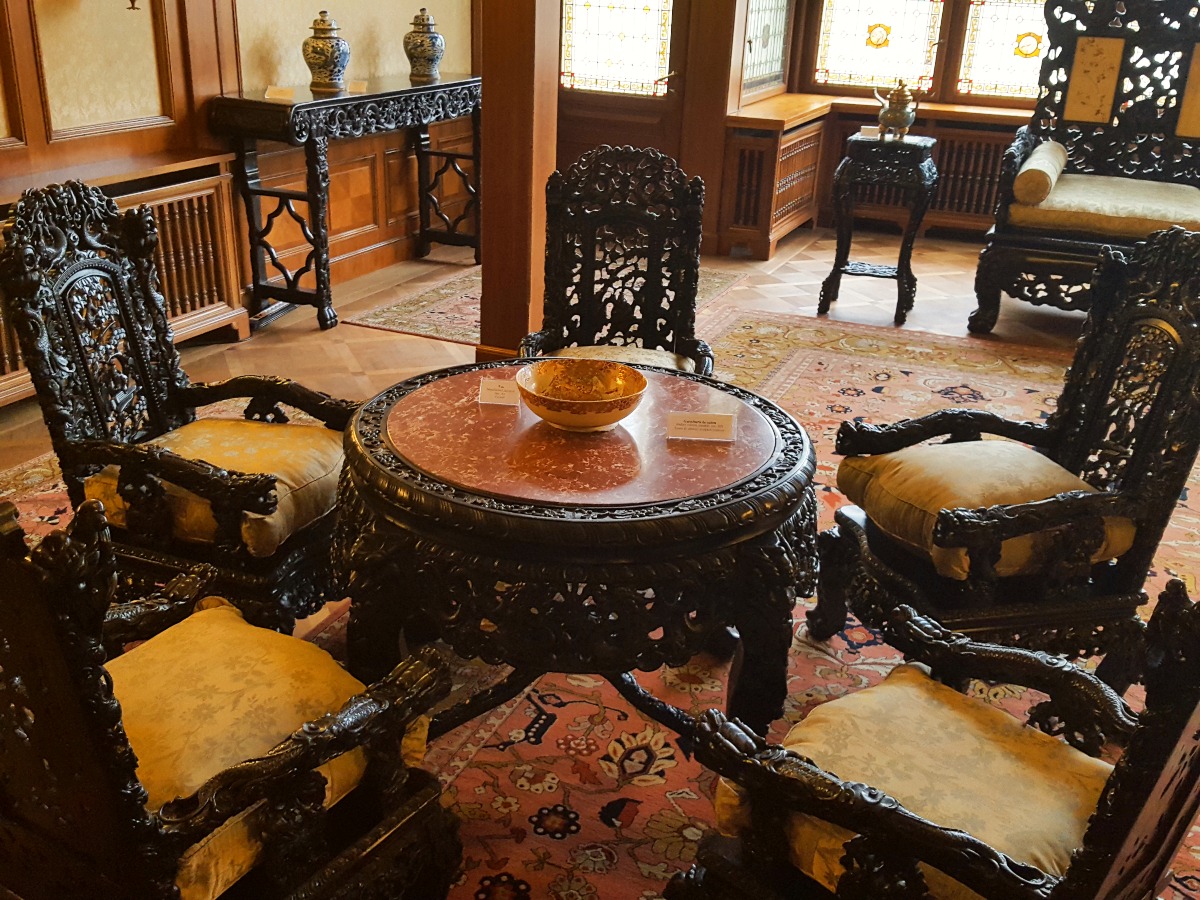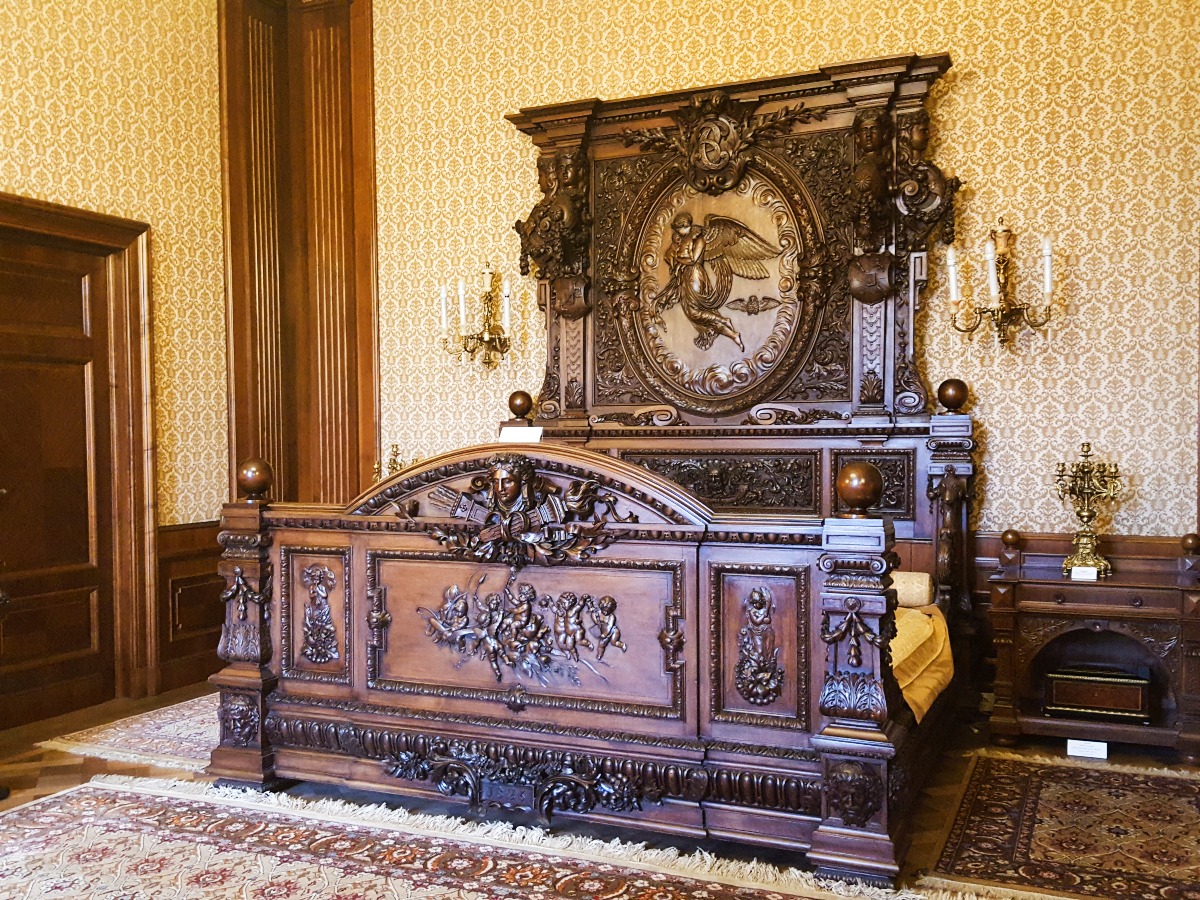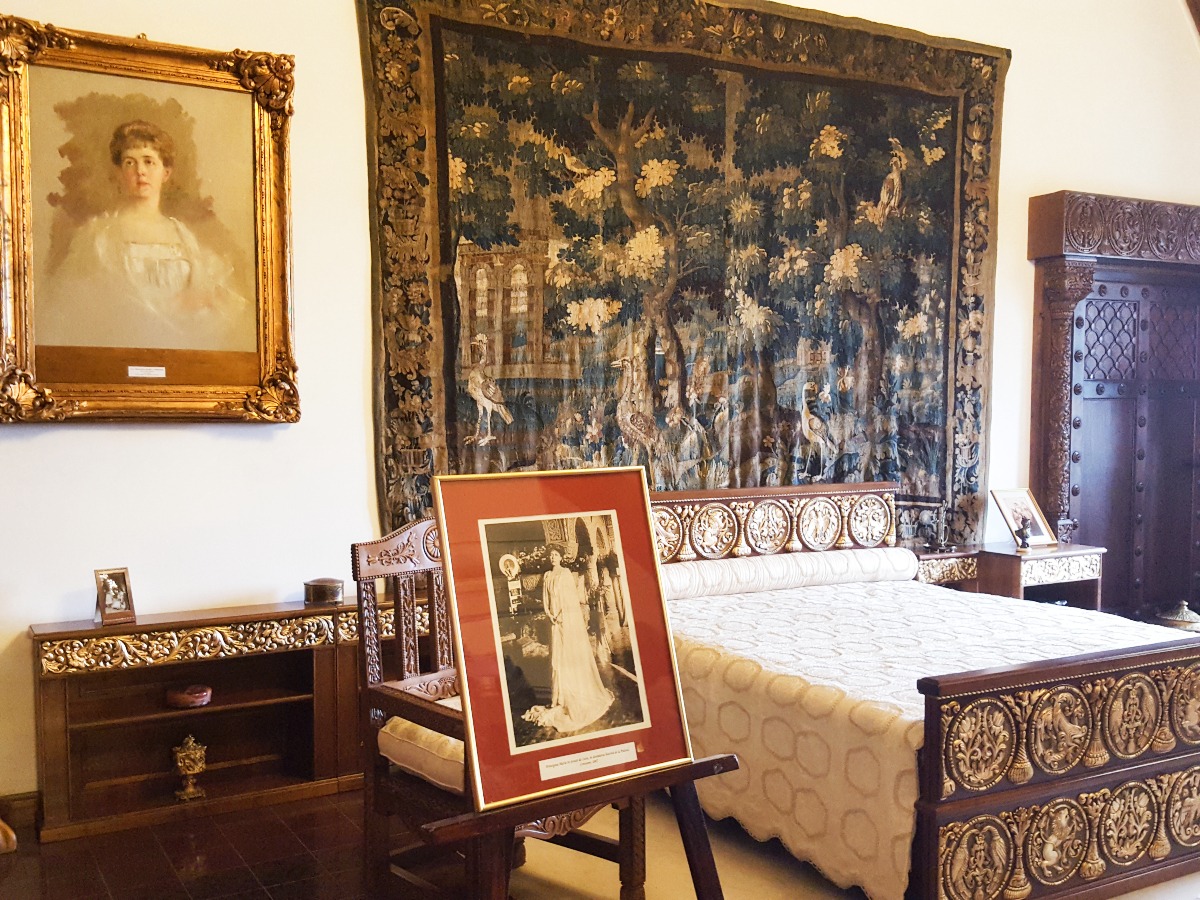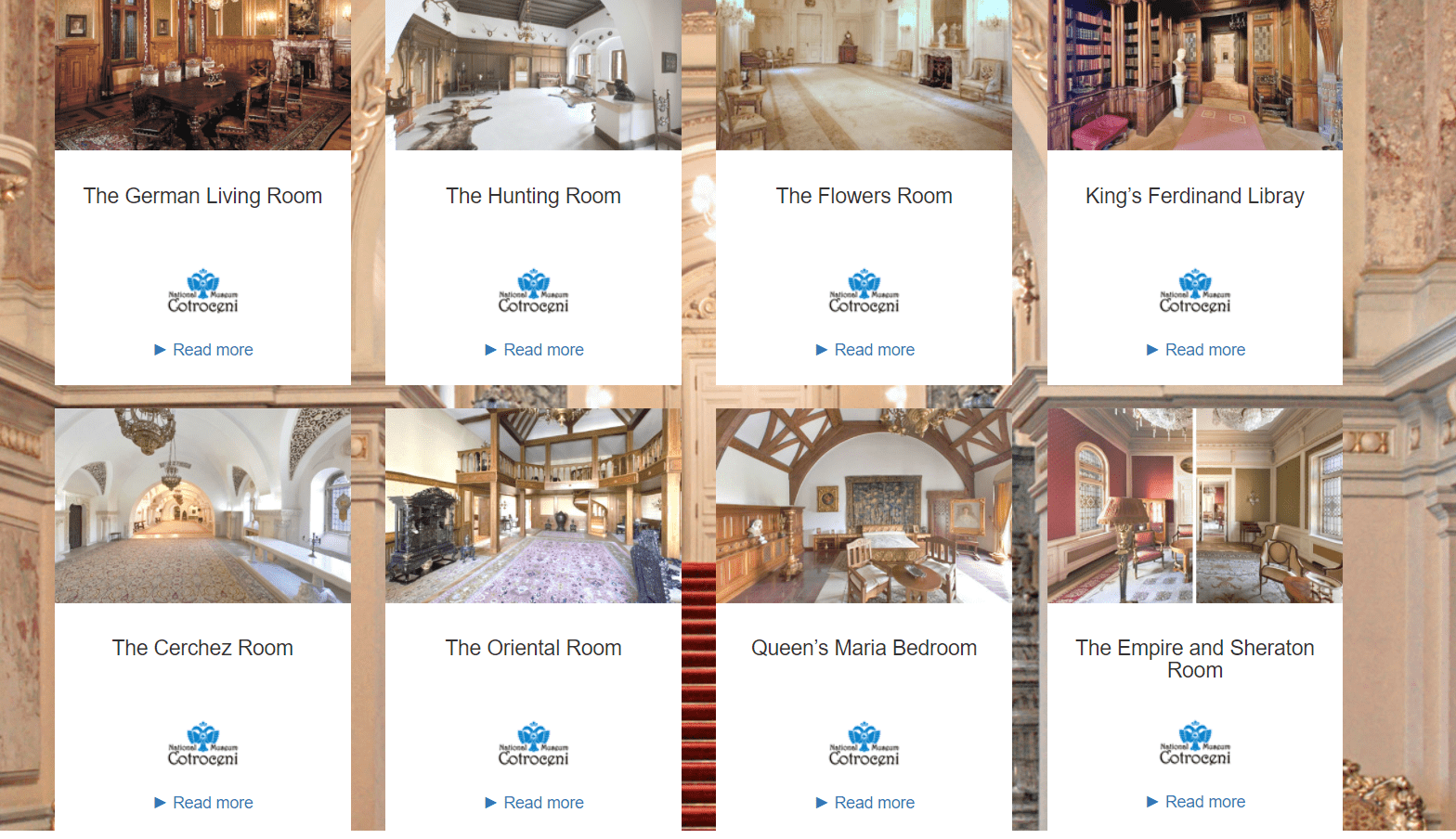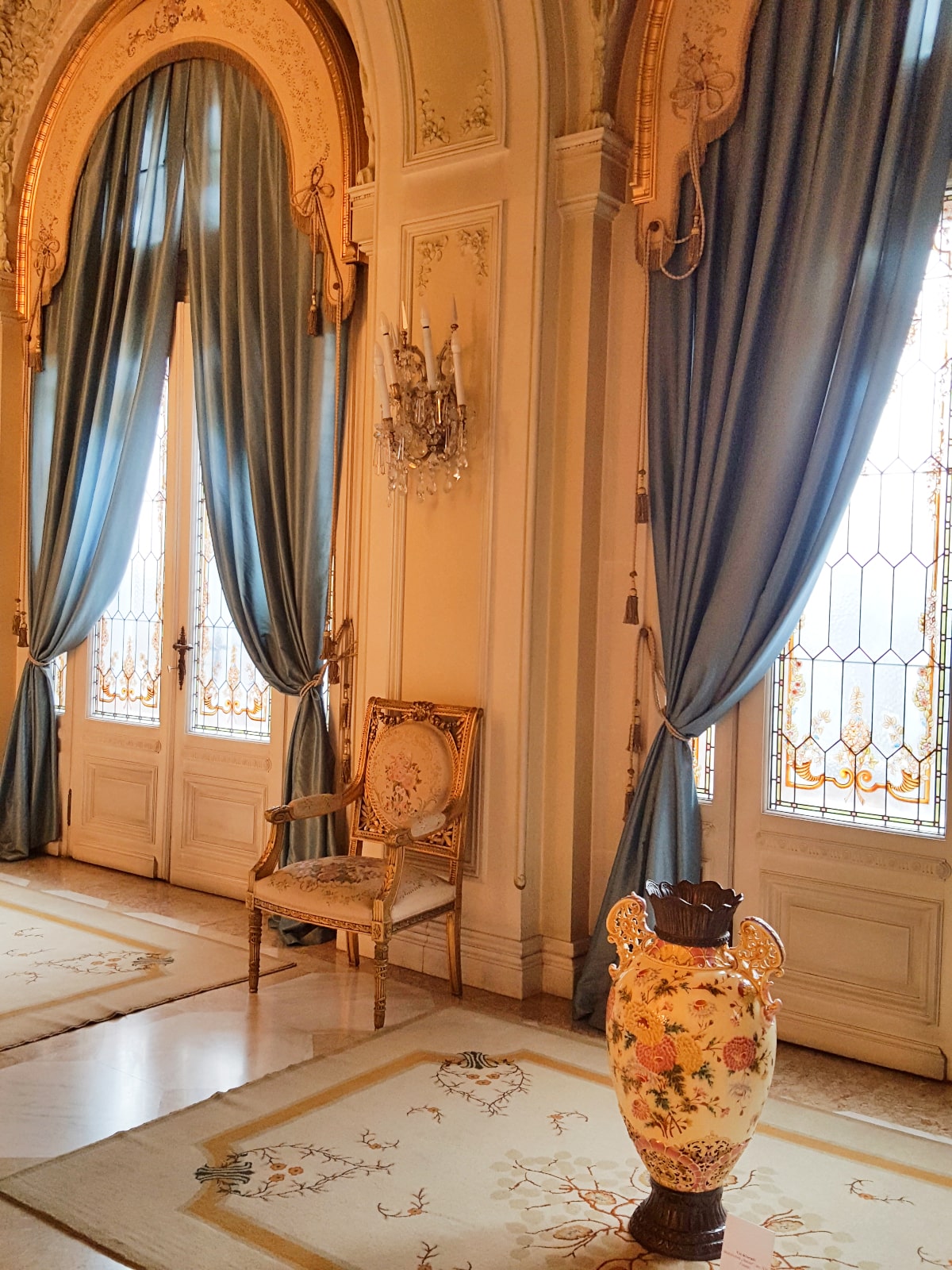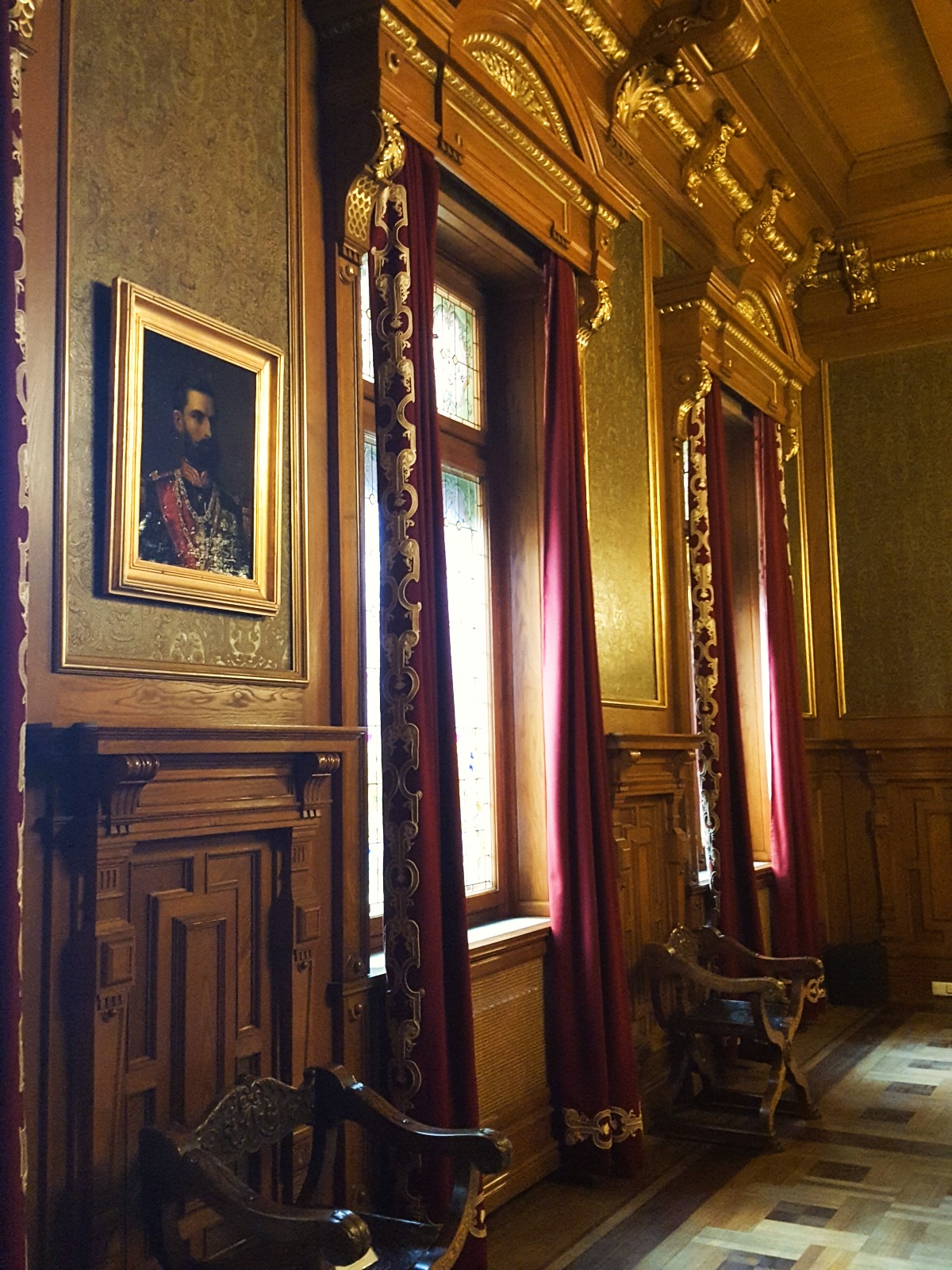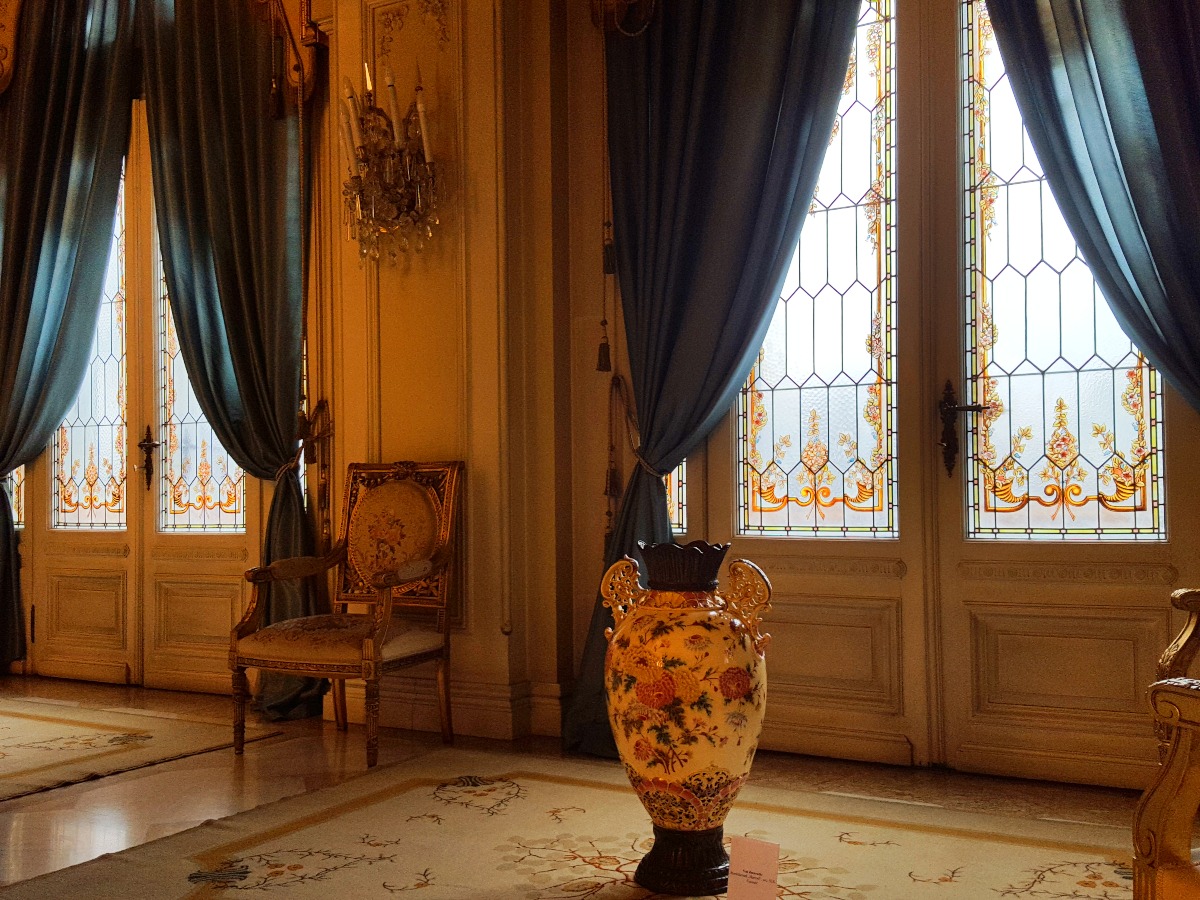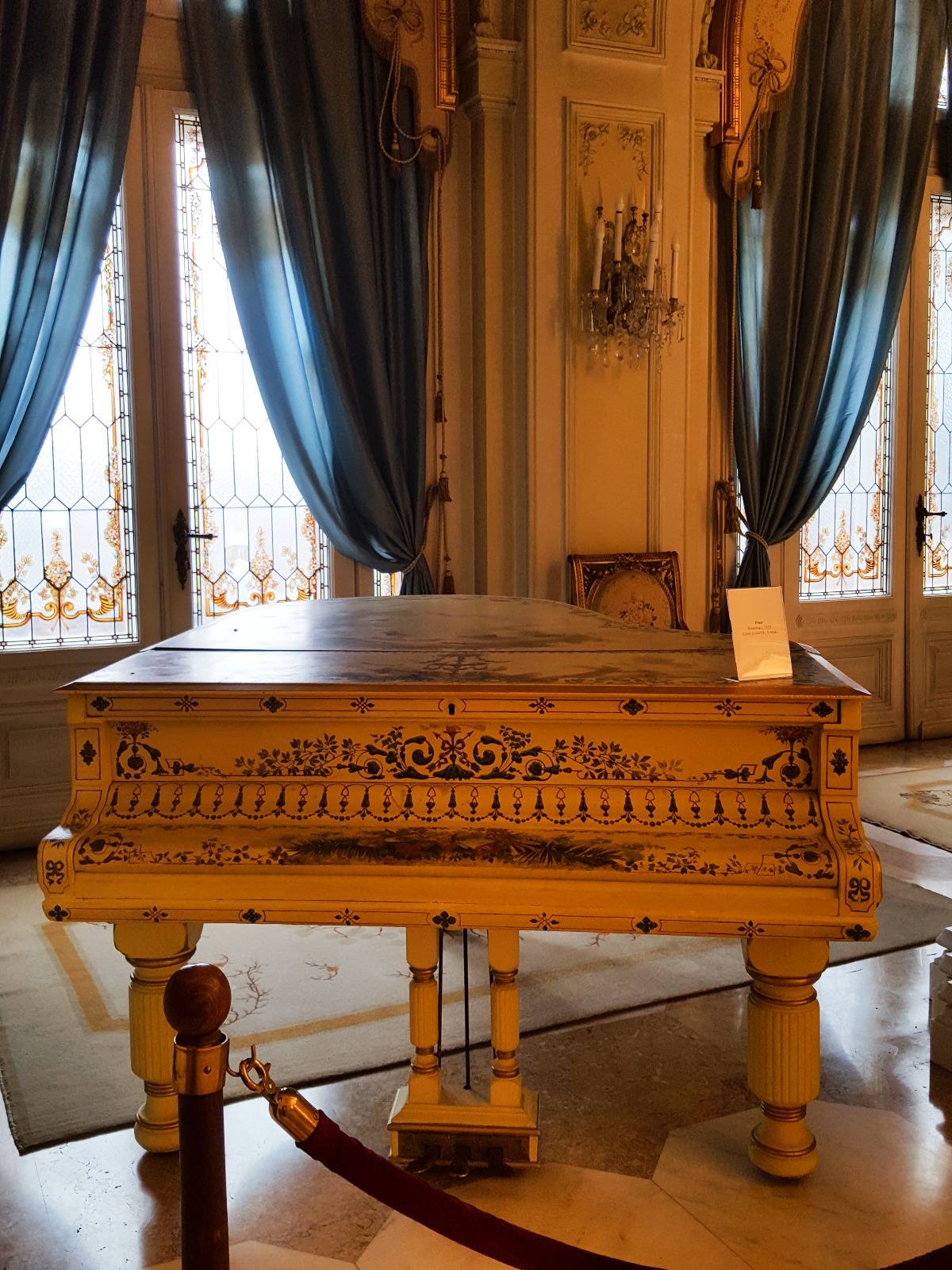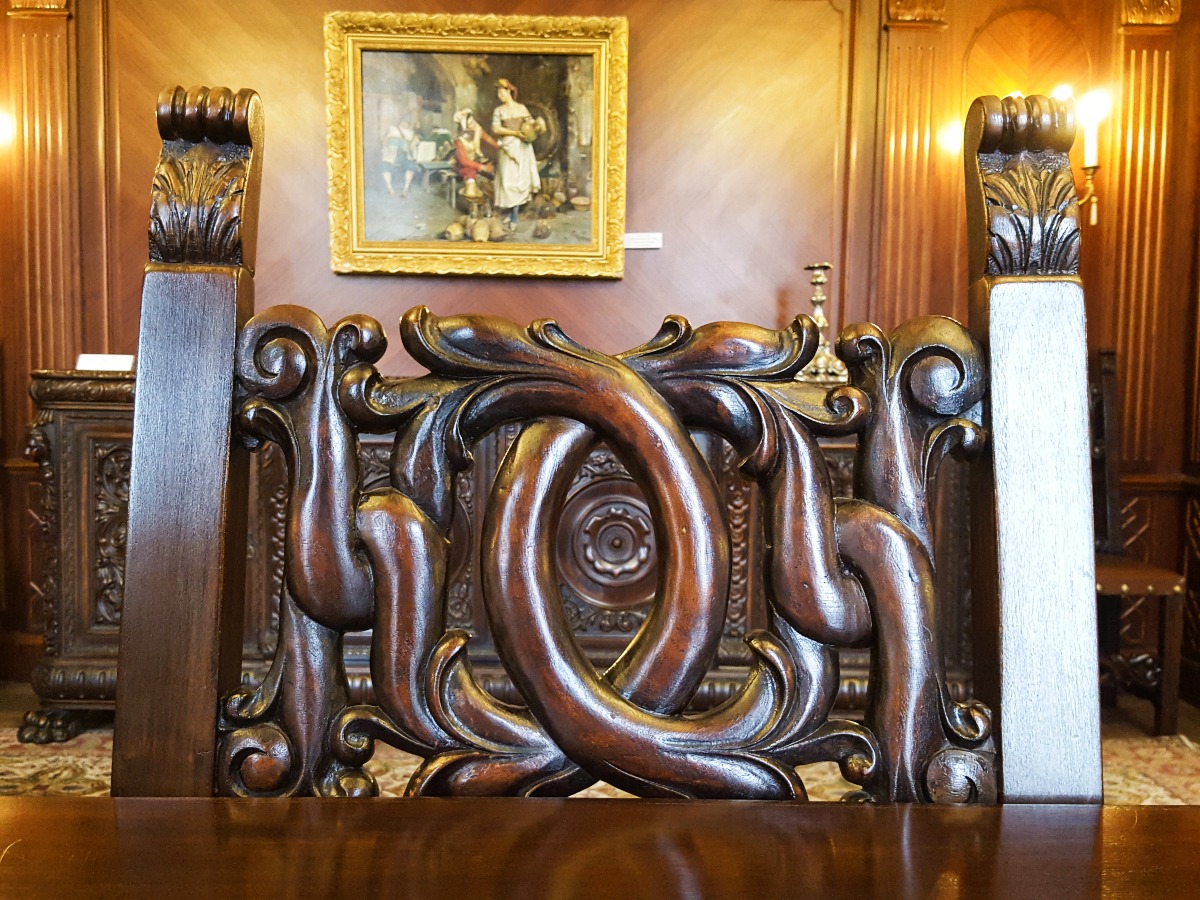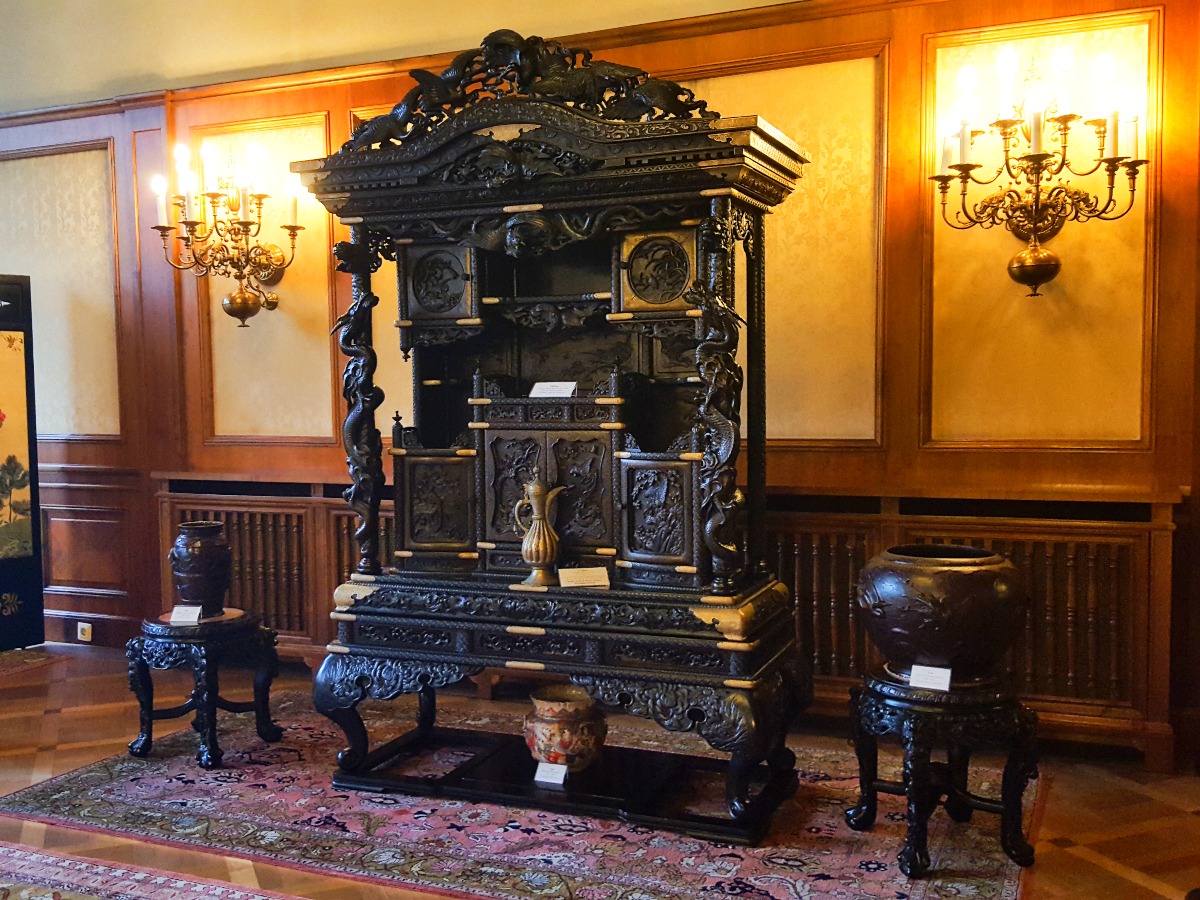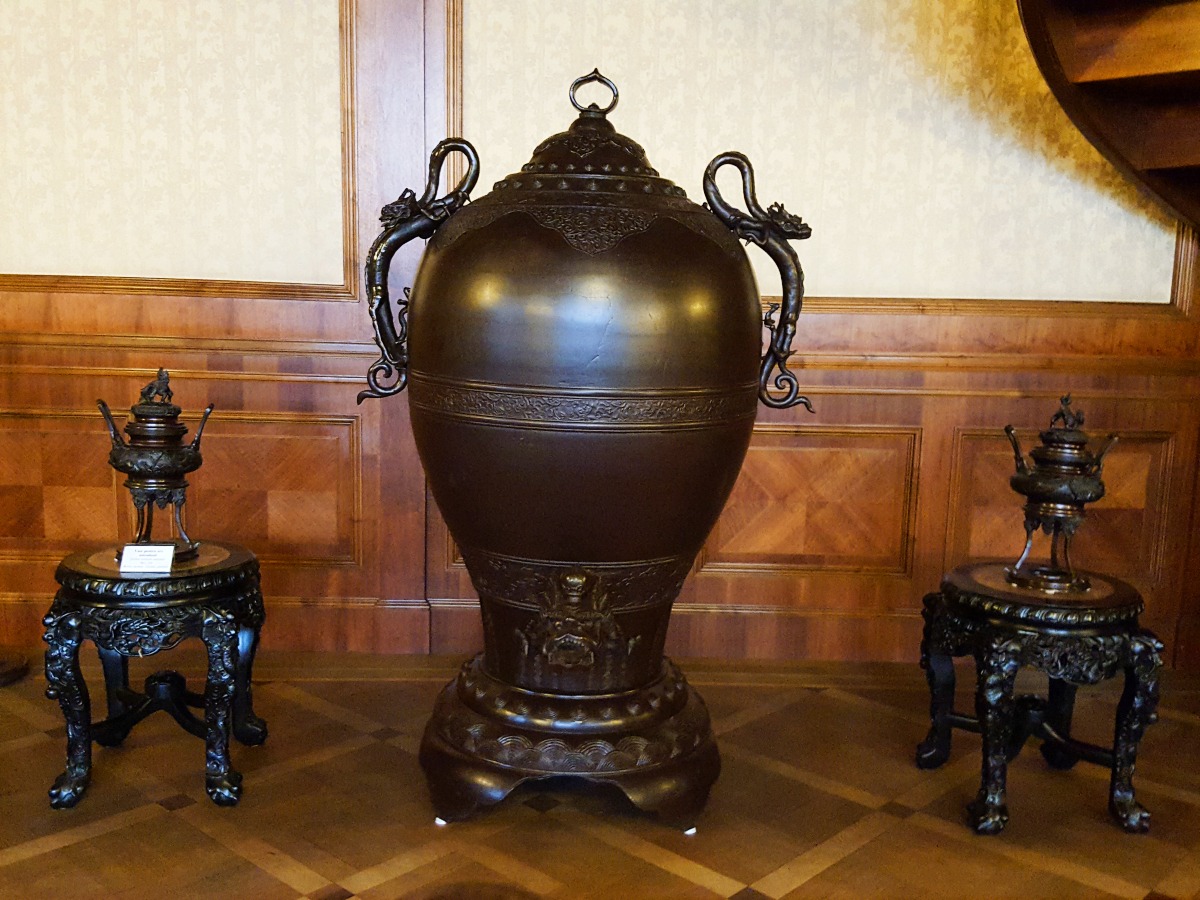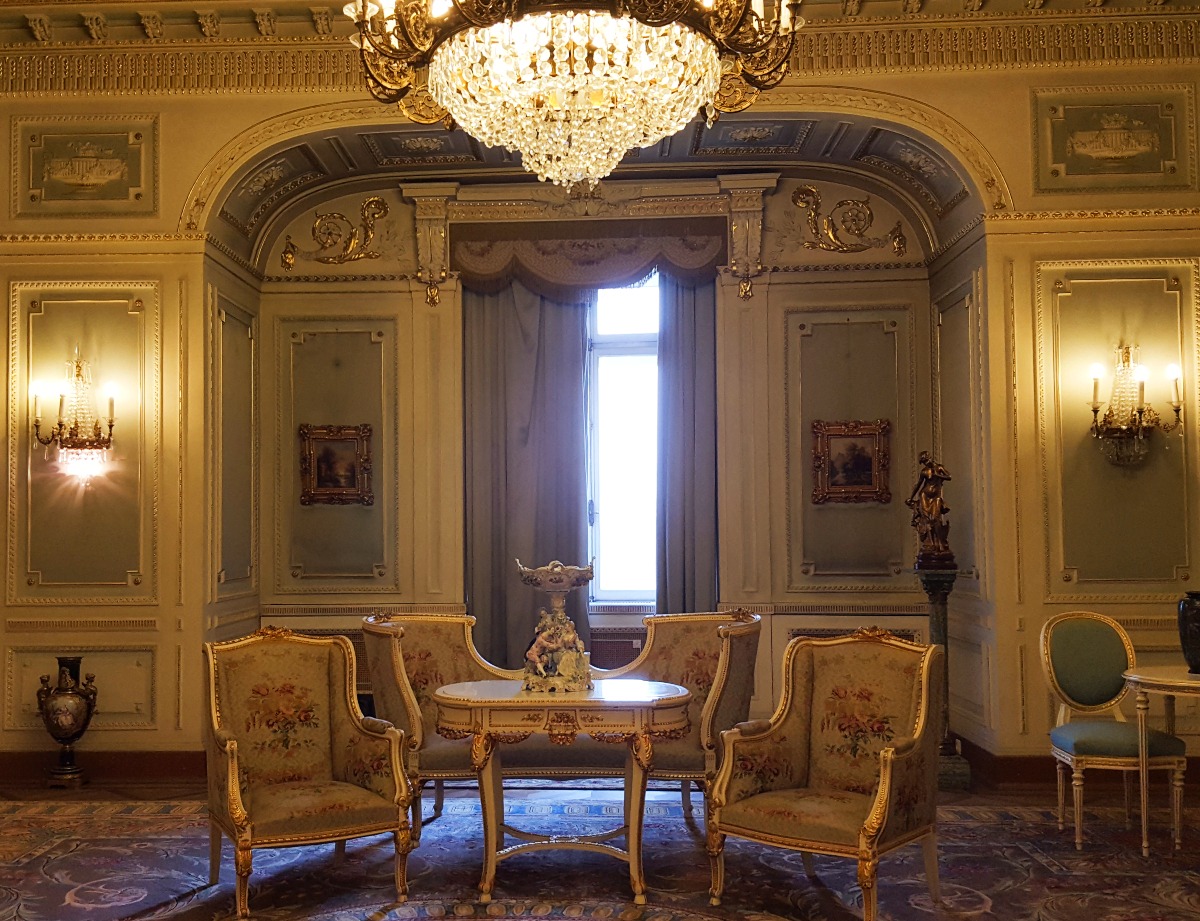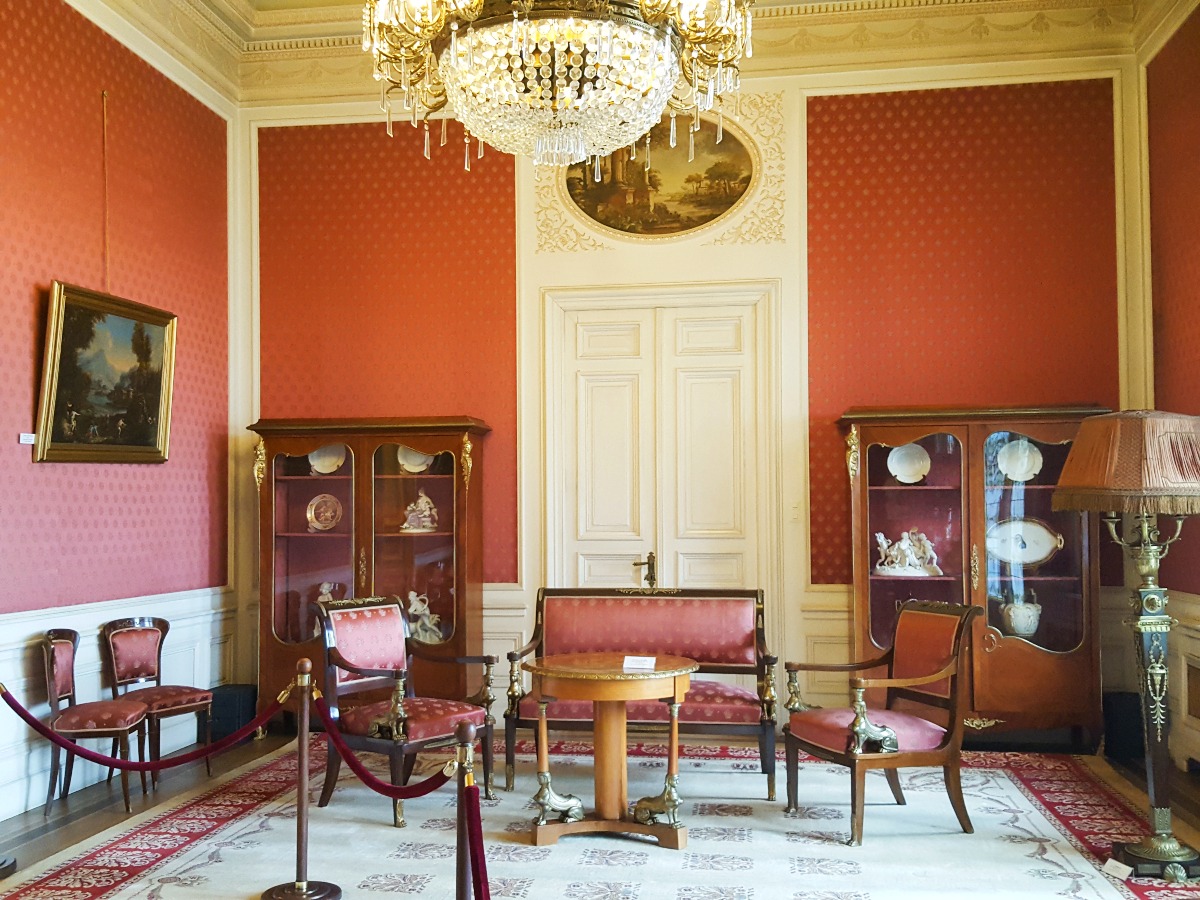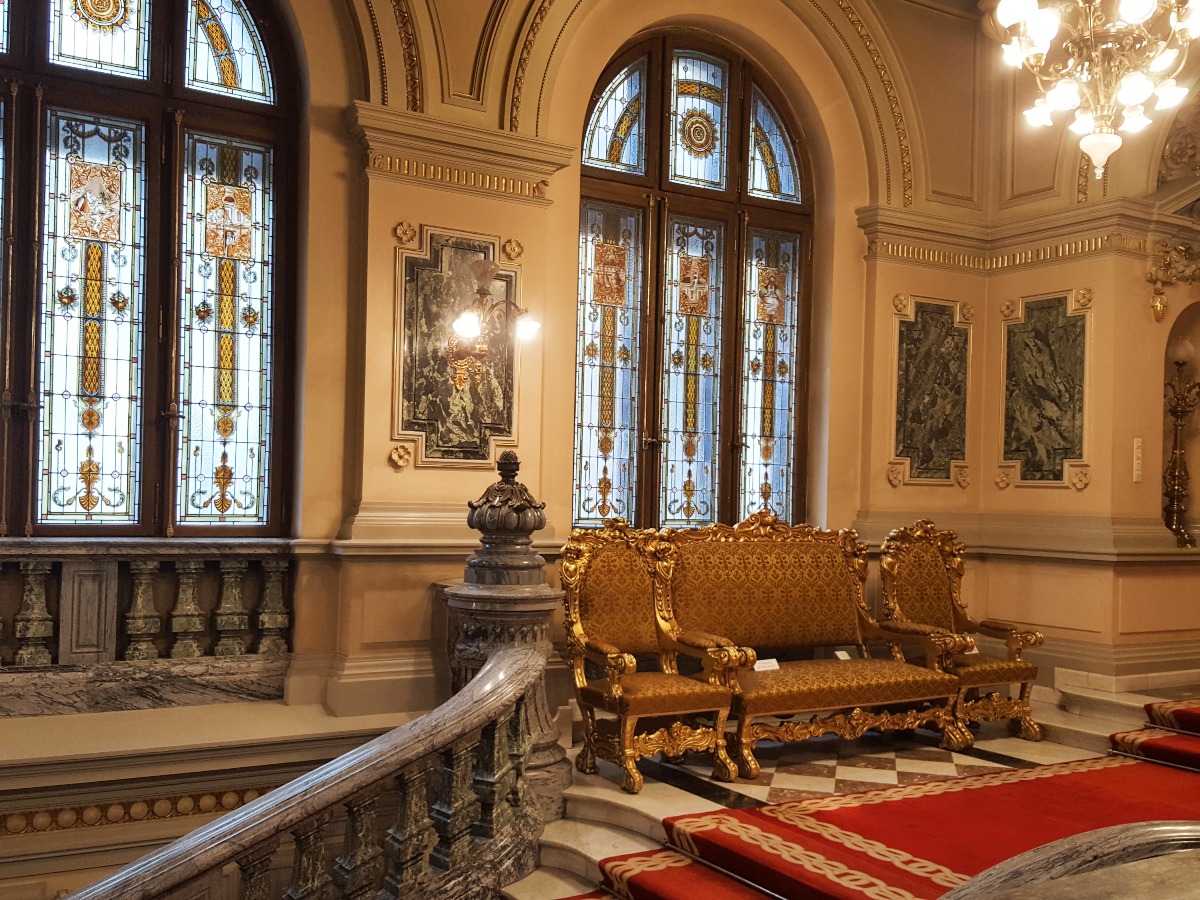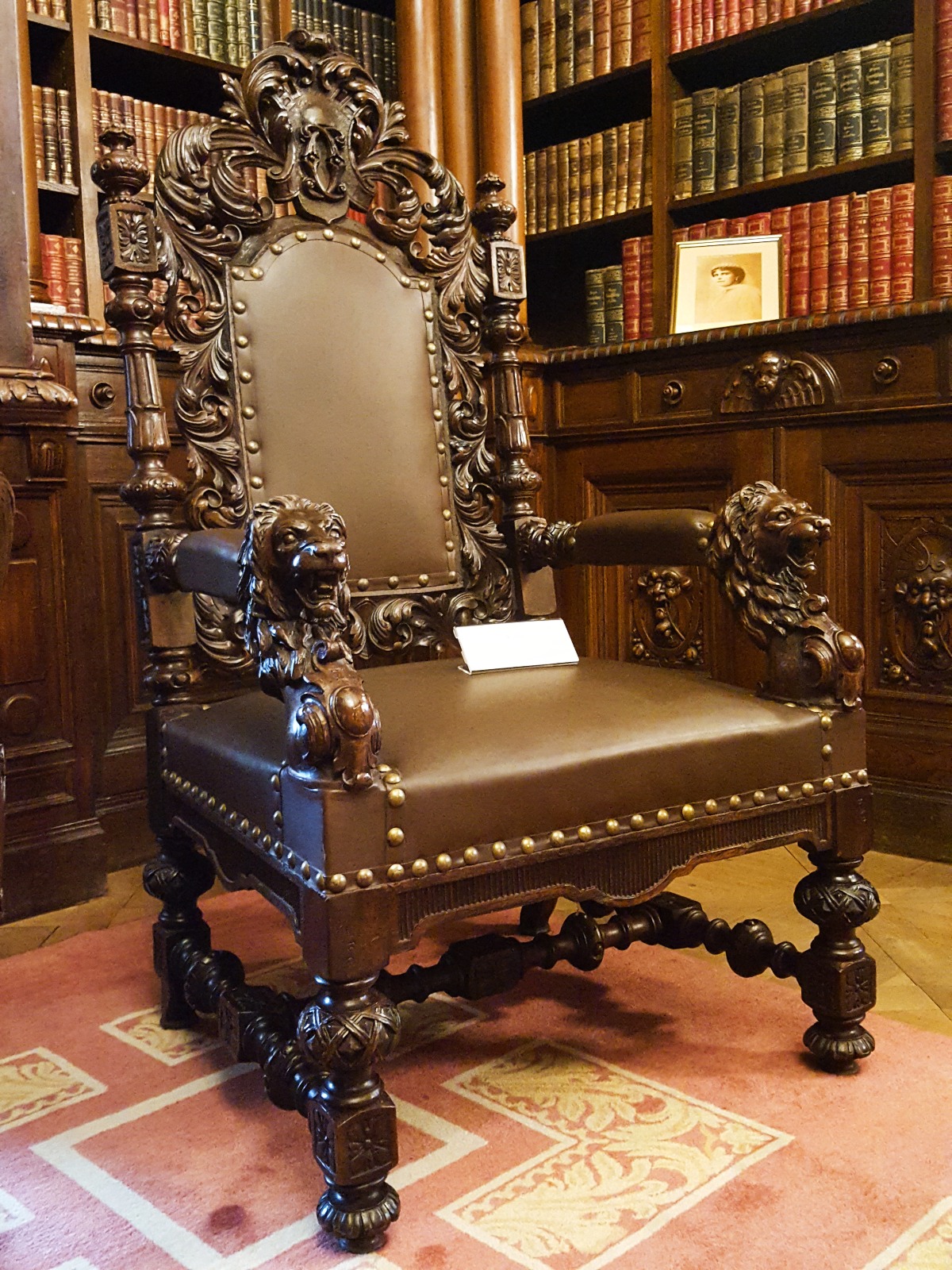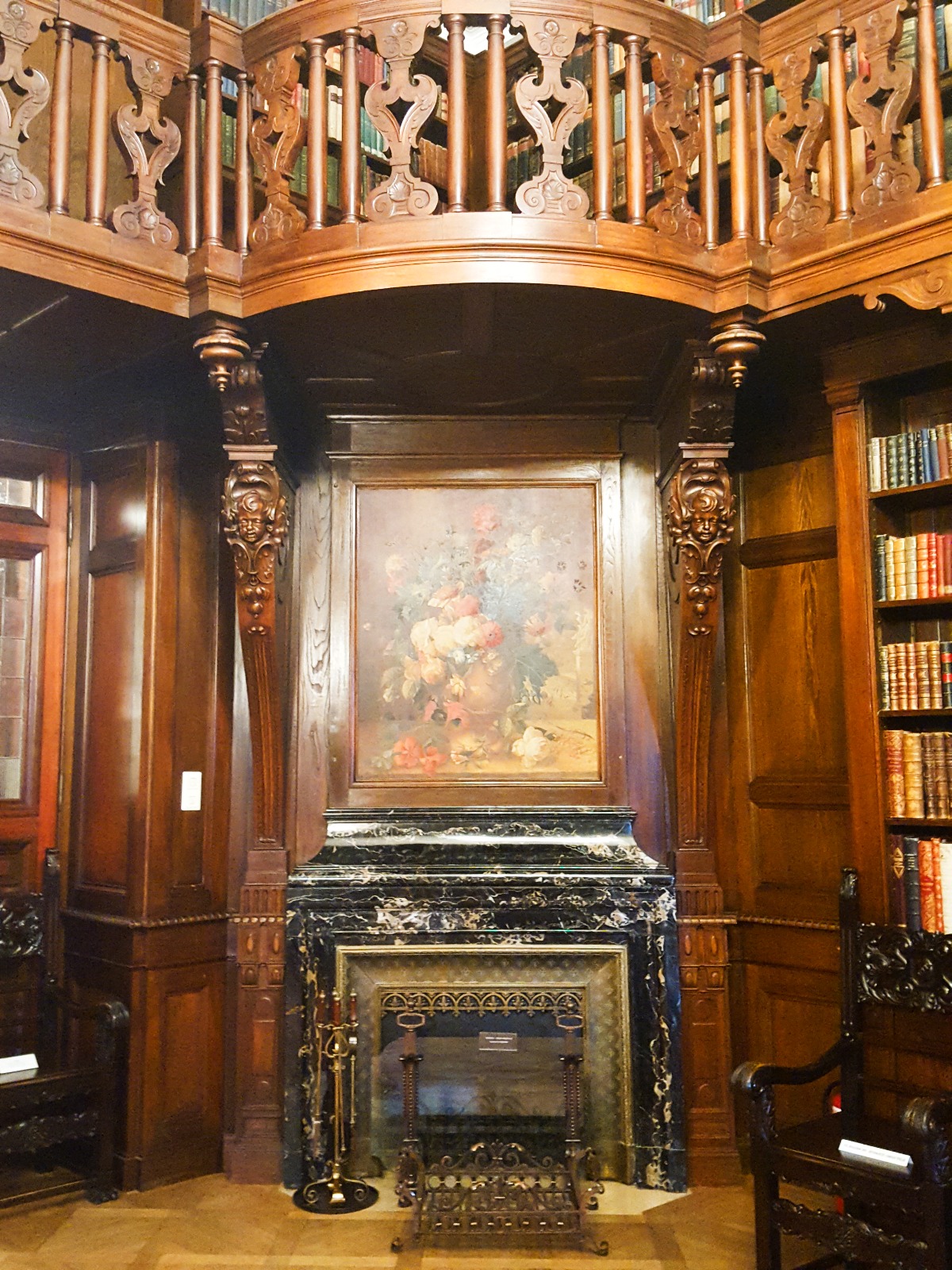The German Living Room
After you have the honor of climbing the impressive marble stairs and after admiring the wonderful design of the sofas and armchairs, which, unfortunately, you can't test their comfort, you will arrive in the German Living Room. This room reflects King’s Carol's taste and admiration for the neo-Renaissance German style. Take your time and pay attention to the richly carved table and chairs, to the amazing fireplace or to the original chandelier dated from 1876. The art lover can admire the paintings, as well. Over the fireplace there is a painting representing a hunting scene made by the Romanian artist Vasile Pop Negreşteanu.
The Hunting Room
A rather austere room, The Hunting Room dates from 1926-1927. It is the opera of the royal court architect Karel Limann and it is decorated in the Italian Renaissance style.
The Flower Room
An absolutely lovely room! The Flower Room immediately conquers visitors with its delicate and feminine style. Going through many style changes, from the Louis XIVth to Secession decoration, after the earthquake from 1977 the room was restored with floral patterns. A piece of resistance in this room is the piano that belonged to Queen Elizabeth and to the princesses. It was black at its beginnings, but the Queen redesigned it in order to better fit into the decoration of the room.
Can you imagine this room turquoise, as the curtains are? And with soft orange furniture? All embroidered with gold thread? For us, it is always a pleasure to leave ourselves abandoned in this room!
King’s Ferdinand Library
Here is the land for book lovers! King’s Ferdinand Library is richly carved, decorated in neo renaissance French style. Now, the library hosts almost 2500 books, all of them original. You can read the titles of the volumes in the libraries. It is interesting to see how diverse the king was reading. In addition, the volumes are available in various languages. It is known that King Ferdinand spoke seven foreign languages fluently!
The library has a secret door that leads directly to the king's room. We let you discover it for yourself!
The Oriental Room
If you haven't been to
Peles Castle, then you should. Queen Mary was a lover of art, and the beautifully carved furniture is a masterpiece that you can admire in both places.
During her stay here, she arranged into this room a painting workshop. Later, the room became the classroom for her daughters. During the communist occupation, here was a ballet room. Now, you can admire the furniture from China which is richly carved in ebony. Also, into this room there is a big pitcher. In the courtyard of the palace there were many pitchers like this in which water was kept. In these, the water temperature remained constant and in summer it was a pleasure to drink cold water during the walk.
The Royal Apartment
The Royal Apartment was arranged for the first royal family of Romania, King Carol I and Queen Elisabeth. The bed, the largest piece of furniture in the palace, was made as a gift by the boyar Golescu. The decorations represent the child that the royal couple lost, but also the child that they wanted very much.
Queen Mary Bedroom
Here was the big bedroom of the Prince and Princess, decorated in the French style. Initially, this bedroom looked differently, but, in 1929, after the death of the King, Queen Mary decided to redecorate it in Tudor Style. Some of the objects that you can see in this room are made into the Sinaia workshop by herself.
French Apartment
Here was the apartment of King Ferdinand and you can see the secret door to the library. At that time, this apartment looked completely different.
During the communist occupation, Ceaușescu, the Romanian communist president until 1989, wanted to redecorate all the rooms from the first floor and transform them into guest rooms for the members of official delegations. He managed to redecorate only this apartment, which he specially prepared for the visit of Queen Elizabeth II of Great Britain. The visit was to follow Ceausescu's visit to London, but Queen Elizabeth II did not return the visit.
Anyway, it is impressive to see the charm of this apartment which was decorated with gilded wood, pink natural silk, 19th-century curtains, with scenes from La Fontaine's fables.
During the tour, you will have the opportunity to visit other rooms of the palace, too. These include Cerchez Room - the place where the evenings were held, the Dining Room - where you will have the opportunity to admire a beautiful table with chairs on which are inserted Celtic symbols reminiscent of the origins of Queen Mary, Children's Room - the only place in the palace where the original faceted crystal windows have been preserved, the Salons where the Queen spent her time when the weather was too bad to go outside.
It is said that all the men in the royal family had poppy-out ears. This is the reason why in all these portraits they appear with their heads turned to one side. But here you will have the opportunity to see the bust of King Ferdinand carved in wood. Apparently, it was the only time the King posed like this. Looking at this bust, you will realize that his big ears are not just a myth.
The Royal Family played a very important role in the educational, cultural, and economic development of Romania. Although the country is not ruled by the Monarchy at present, the cult of the king and queen is well represented by people that do not hesitate to admire the results of their work for the benefit of the community.
As a tribute to the royal family and, especially to Queen Mary and King Ferdinand, we recommend a
visit to Peles Castle. Besides the fact that you will have the opportunity to admire another architectural jewel, you can enjoy the mountain landscape and the fresh air.
If you want to know more about the communist period and the leader of Romania at that time, do not hesitate to pay a
visit to the Parliament Palace - you will see with your own eyes the great plan of Nicolae Ceaușescu to build an impressive building that broke world records, or the
Primăverii (Spring) Mansion -
the residence of the Ceausescu couple.
Enjoy your visit to the Cotroceni National Museum!
Cotroceni National Museum Virtual Tour
Opening hours:
Monday – CLOSED
Tuesday – 9.30AM - 5.30PM
Wednesday – 9.30AM - 5.30PM
Thursday – 9.30AM - 5.30PM
Friday – 9.30AM - 5.30PM
Saturday – 9.30AM - 5.30PM
Sunday – 9.30AM - 5.30PM
Ticket Price/Guided Tours
STANDARD TOUR *English Guide, French Guide, Italian Guide, Spanish Guide
Adults - 60 LEI (~ 13 Euro)
Retired people - 30 LEI (~ 6 Euro)
Students - 15 LEI (~ 3 Euro)
COMPLETE TOUR *English Guide, French Guide, Italian Guide, Spanish Guide
Adults - 70 LEI (~ 15 Euro)
Retired people - 35 LEI (~ 7 Euro)
Students - 17 LEI (~ 4 Euro)
Guided Tours:
For Cotroceni National Museum the tours are done only with a guide!
The presentation of an original identity document (id card, passport) must be presented at the entrance of the Cotroceni National Museum.
*Appointment by e-mail vizitare@muzeulcotroceni.ro or phone 004 021 317 31 07 at least 24 hours in advance.
Get directions
